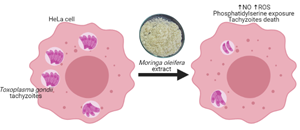Published online by Cambridge University Press: 30 June 2021

Toxoplasma gondii is the causative agent of toxoplasmosis, and an important problem of public health. The current treatment for toxoplasmosis is the combination of pyrimethamine and sulphadiazine, which do not act in the chronic phase of toxoplasmosis and have several side-effects. This study evaluated the anti-T. gondii activity and potential mechanism of Moringa oleifera seeds’ aqueous extract in vitro. The concentration of M. oleifera extract in HeLa cells was determined by 3-(4,5-dimethylthiazol-2-yl)-2,5-diphenyltetrazolium bromide cell viability assays. The presence of T. gondii was assessed by quantitative polymerase chain reaction and toluidine blue staining. Pyrimethamine and sulphadiazine were used as drug controls. Modifications in T. gondii morphology and ultrastructure were observed by electron microscopy. In vitro, the M. oleifera extract had no toxic effect on HeLa cells at concentrations below 50 μg mL−1. Moringa oleifera extract inhibits T. gondii invasion and intracellular proliferation with similar results for sulphadiazine + pyrimethamine, and also shows cellular nitric oxide production at a concentration of 30 μg mL−1. Electron microscopy analyses indicated structural and ultrastructural modifications in tachyzoites after treatment. We also observed an increase in reactive oxygen species production and a loss of mitochondrial membrane integrity. Nile Red staining assays demonstrated a lipid accumulation. Annexin V–fluorescein isothiocyanate and propidium iodide staining demonstrated that the main action of M. oleifera extract in T. gondii tachyzoites was compatible with late apoptosis. In conclusion, M. oleifera extract has anti-T. gondii activity in vitro and might be a promising substance for the development of a new anti-T. gondii drug.